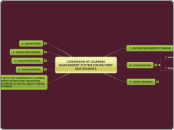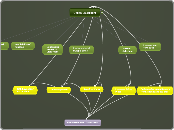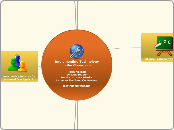CONVERSION OF LEARNING MANAGEMENT SYSTEM FOR MILITARY NEW RECRUITS
10. NEW EFFECTIVE CONVERSION OF LEARNING MANAGEMENT SYSTEM FROM TRADITIONAL LECTURE FORMAT TO VIRTUAL REALITY ONLINE BLENDED FORMAT
8. Instructional Plan
Introduction
Activate attention – How will you gain learners’ attention?
The recruit's attention will be activated by establishing clear and specific training goals based on their current level of knowledge, skills, and abilities.
Establish instructional purpose – How will you inform learners of the instructional goal?
Informing recruits of the instructional goal will involve defining and describing key terms of training material prior to presenting
the more complex conceptual relationships between the terms.
Arouse interest and motivation – How will you stimulate learners’ attention? How will you stimulate the learners’ motivation?
Recruits attention will be stimulated with the virtual equipment and attachments, also with presented training materials using
pictures and words spatially separated, and concurrently, rather than separated in time. In addition, this population has its own reward system of levels, ranks, badges, awards, etc...
Preview lesson – How will you provide an overview of the lesson?
An overview of the lesson for recruits will be provided by a virtual reality tutorial or instruction from a level Commander.
Body
Recall prior knowledge – How will you stimulate recall of prior knowledge?
To stimulate recall of prior knowledge, advance organizers will be utilized to provide recruits with relevant or background information prior to learning in order to facilitate the integration of newly acquired information with prior knowledge.
Process information – How will you present information and examples?
Information and examples will be presented by organizing the most important material into visual, auditory, conversational pieces to help recruits solve problems initially with guided practice and then on their own to develop expertise.
Focus attention – How will you gain and direct attention?
To gain and direct attention for recruits, signaling will be used to emphasize the most important training material by providing visual (arrows, animations, simulations, etc...) and auditory cues.
Employ learning strategies – How will you guide or prompt use of learning strategies?
Guiding learning strategies will include worked out examples, faded examples, completion problems, conventional problem-solving, minimally- guided instruction, and cognitive apprenticeship.
Practice – How will you provide for and guide practice?
The practice will be a training event consisting of deliberate practice presenting recruits with opportunities to engage in practice exercises, which provides specific feedback to assist with skill mastery. Also, distributed practice will be incorporated during training to help with overall skill mastery, maximize long-term learning, and distribute practice over multiple, short training sessions that are separated in time, as opposed to massing practice all at once.
Evaluate feedback – How will you provide feedback?
Immediate feedback will immediately follow errors made during problem-solving, provide recruits with corrections, hints or explanations to help them solve the solutions steps accurately, address recruit errors by explaining the rationale behind correct solutions (explanatory feedback), as opposed to only informing recruits whether their solution was right or wrong (corrective feedback).
Conclusion
Summarize and review – How will you provide a summary and review?
The summary and review will be provided to recruits following completion of a training task or sequence level. It will include
corrective and explanatory feedback, as well as suggestions for performance improvement.
Transfer knowledge – How will you enhance transfer?
This will be done via computer or virtual reality equipment by presenting real-time, real-world sequence complex material, which are manageable segments of information that present and explain steps required for problem-solving ranging from a novice level to an expert level of knowledge acquisition and practical application.
Goal: [Insert the instructional goal from project u06a1 – Analyzing Learning Tasks here.]
CONDITIONS
Given a standard 1:50,000 scale military map, virtual reality equipment (hardware/software)
Given a standard 1:50,000 scale military map, virtual reality equipment (hardware/software)
Learning Goals
1). Recruits will be able to identify terrain features on a map and
illustrate proper map reading utilizing virtual reality equipment KNOWLEDGE (Some Prior Knowledge/Minimal Gaps
2). Recruits will be to measure distance on a map utilizing virtual reality equipment KNOWLEDGE (Some Prior Knowledge/Minimal Gaps)
Type of Learning: [Knowledge Category of Learning]
Objective: [Learning Tasks
1- Identify application knowledge of map reading to fellow recruits and chain of command
2- Explain land navigation with feedback when it is appropriate to use
3- Demonstrate map reading to the chain of command and fellow recruits in a timely
manner
Learning Objectives
At the completion of virtual reality training sequences, recruits will be able to:
1). Demonstrate different terrain features on a map to chain of command and fellow recruits for each prescribed sequence (easy, medium, hard, expert)
2). Assess map reading ability with virtual reality equipment effectively by 80%
3). Identify the five major and three minor terrain features on the map in a timely manner
Standard Performance Measures
1. Identify the five major terrain features on a map using virtual reality
2. Identify the three minor terrain features on a map using virtual reality
3. Measure the straight-line distance on the map using virtual reality with no more than 5 percent error
4. Measure the curved-line distance using virtual reality with no more than 10 percent error]
Introduction
Activate attention – How will you gain learners’ attention?
The recruit's attention will be activated by establishing clear and specific training goals based on their current level of knowledge, skills, and abilities.
Establish instructional purpose – How will you inform learners of the instructional goal?
Informing recruits of the instructional goal will involve defining and describing key terms of training material prior to presenting
the more complex conceptual relationships between the terms.
Arouse interest and motivation – How will you stimulate learners’ attention? How will you stimulate the learners’ motivation?
Recruits attention will be stimulated with the virtual equipment and attachments, also with presented training materials using
pictures and words spatially separated, and concurrently, rather than separated in time. In addition, this population has its own reward system of levels, ranks, badges, awards, etc...
Preview lesson – How will you provide an overview of the lesson?
An overview of the lesson for recruits will be provided by a virtual reality tutorial or instruction from a level Commander.
Body
Recall prior knowledge – How will you stimulate recall of prior knowledge?
To stimulate recall of prior knowledge, advance organizers will be utilized to provide recruits with relevant or background information prior to learning in order to facilitate the integration of newly acquired information with prior knowledge.
Process information – How will you present information and examples?
Information and examples will be presented by organizing the most important material into visual, auditory, conversational pieces to help recruits solve problems initially with guided practice and then on their own to develop expertise.
Focus attention – How will you gain and direct attention?
To gain and direct attention for recruits, signaling will be used to emphasize the most important training material by providing visual (arrows, animations, simulations, etc...) and auditory cues.
Employ learning strategies – How will you guide or prompt use of learning strategies?
Guiding learning strategies will include worked out examples, faded examples, completion problems, conventional problem-solving, minimally- guided instruction, and cognitive apprenticeship.
Practice – How will you provide for and guide practice?
The practice will be a training event consisting of deliberate practice presenting recruits with opportunities to engage in practice exercises, which provides specific feedback to assist with skill mastery. Also, distributed practice will be incorporated during training to help with overall skill mastery, maximize long-term learning, and distribute practice over multiple, short training sessions that are separated in time, as opposed to massing practice all at once.
Evaluate feedback – How will you provide feedback?
Immediate feedback will immediately follow errors made during problem-solving, provide recruits with corrections, hints or explanations to help them solve the solutions steps accurately, address recruit errors by explaining the rationale behind correct solutions (explanatory feedback), as opposed to only informing recruits whether their solution was right or wrong (corrective feedback).
Conclusion
Summarize and review – How will you provide a summary and review?
The summary and review will be provided to recruits following completion of a training task or sequence level. It will include
corrective and explanatory feedback, as well as suggestions for performance improvement.
Transfer knowledge – How will you enhance transfer?
This will be done via computer or virtual reality equipment by presenting real-time, real-world sequence complex material, which are manageable segments of information that present and explain steps required for problem-solving ranging from a novice level to an expert level of knowledge acquisition and practical application.
Remotivate and close – How will you provide remediation and closure?
This will be accomplished by prompting recruits to reflect upon their own training outcomes and to consider ways in which they could improve their performance.
Assessment
Assess performance – How will you conduct assessment?
Assessment will be conducted by testing and on-the-job performance. It will be utilized as a training tool in accordance with testing military trainees on the material.
Evaluate feedback and remediate – How will you provide feedback and remediation?
Feedback will be provided by after-action reviews and reflective prompting. In light of the mode of delivery, feedback will also be immediate, explanatory, and entail metacognitive prompting
6. Learner Assessments
TYPES OF ASSESSMENTS
1) Post-Assessment
2) End Of Sequence Level Knowledge Test
3) Final Simulation Assessment
4) Authentic Situational Judgment Test
5) On-The-Job Observation
TEST MODELS
1) Matching
2) Educational Games
3) Fill In Blanks
4) Reviews
5) Direct Feedback
6) Realtime Progress Monitors
7) Individual Observation
8) Group Observation
4. Learner Characteristics
1) Adult Learners
2) Self-Directed
3) Autonomous
4) Mature
5) Professionally Responsible
6) Dependable
7) Persistent
8) Resourceful
9) Experiential Richness
10) International Mastery Of Location & Events
11) Intercultural Awareness
12) Intrinsically Motivated
13) History Of Organizational Commitment
14) Sense Of Community
15) Schedule & Work Flexibility
16) Goal-Oriented
17) Disciplined
18) Leadership Savvy
19) Different Management Styles
20) Constructive Unit
21) Sharp
22) Positive Disposition
23) Varied Interests
24) Coping Abilities
2. Learner Needs
1) Upgrade In Technology
2) Improve Performance
3) Decrease Burnout
4) Improve Effectiveness
5) Increase Speed & Precision
6) Enhance Learning
7) Realtime Accurate Feedback
8) Safe Training Environment
9) Adaptable Learning Platform
10) Improve Learner Engagement
11) Increase Motivation For Learning
12) Lightweight Innovative Equipment
13) Accessibility In Learning
14) Flexibility In Learning
15) Affordable Technology
9. Delivery Strategies
STRATEGIES
1. Multimedia, 2. Spatial/Temporal Contiguity, 3. Segmenting/Sequencing Modality, 4. Signaling, 5. Personalization, 6. Animation, and 7. Analogizing and Concretizing
MODE OF DELIVERY
the mode of delivery will be 21st century augmented reality and virtual worlds, with virtual settings for individuals and groups considering the following: word processed files, ebooks, audio and video files, synchronous and asynchronous online discussions, online games abd simulations and virtual world experiences
3. Learning Context
1) Cost Of Training
2) Hours Of Classroom Training
3) Hours of Field Training
4) Learning Tutorials
5) Hours Of Online/Blended Virtual Reality Training
6) Range Of Training
7) Crosstraining Protocol
8) Computer Interactiveness
9) Interactiveness With Other Trainees
10) Software Inclusions
11) Hardware Attachments
12) Examination Of Space Proximity
13) Sequence Levels Of Courses (Novice, Journey men, Expert)
14) Curriculum Planning
15) Implementation
16) Evaluation
17) Stakeholders' Collaboration Hours
7. Strategies For Effective Assessment Instruments
1) Clarify The Specific Purposes Of The Assessment
2) Develop An Assessment Specification Or Blueprint That Elaborates On The Definition Of Land Navigation Competence
3) Design An Assessment Tool Or Set Of Tools
4) Ensure Assessment Tools Have Good Psychometric Qualities
5) Ensure The Assessment Is Acceptable To Test Takers
6) Budget For Sufficient Administrative Support To Adequately Develop & Maintain The Assessment System
Subtopic
5. Learner Tasks
LEARNING GOALS
1) Recruits Will Be Able To Identify Terrain Features On A Map & Illustrate Proper Map Reading Utilizing Virtual Reality Equipment
2) Recruits Will Be Able To Measure Distance On A Map Utilizing Virtual Reality Equipment
LEARNING TASKS
1) Identify Application Knowledge Of Map Reading To Fellow Recruits & Chain Of Command
2) Explain Land Navigation With Feedback When It Is Appropriate To Use
3) Demonstrate Map Reading To The Chain Of Command & Fellow Recruits In A Timely Manner
LEARNING OBJECTIVES
1) Demonstrate Different Terrain Features On A Map To Chain Of Command & Fellow Recruits For Each Prescribed Sequence
2) Assess Map Reading Ability With Virtual Reality Equipment Effectively By 80%
3) Identify The Five Major & Three Minor Terrain Features On The Map In A Timely Manner
STANDARD PERFORMANCE MEASURES
1) Identify The Five Major Terrain Features On A Map Using Virtual Reality
2) Identify The Three Minor Terrain Features On A Map Using Virtual Reality
3) Measure The Straight-Line Distance On The Map Using Virtual Reality With No More Than 5% Error
4) Measure The Curved-Line Distance Using Virtual Reality With No More Than 10% Error
1. MILITARY NEW RECRUITS TRAINING
a). Land Navigation Mapping
b). Marching









